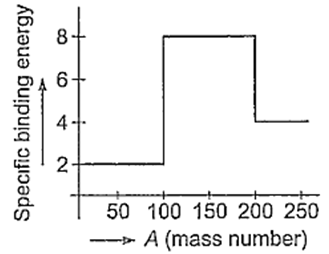 Multiple Choice Questions
Multiple Choice QuestionsThe phenomena in which proton flips is
nuclear magnetic resonance
lasers
radioactivity
nuclear fusion
Assume the graph of specific binding energy versus mass number is as shown in the figure. Using this graph, select the correct choice from the following.

Fusion of two nuclei of mass number lying in the range of 100 < A < 200 will release energy
Fusion of two nuclei of mass number lying in the range of 51 < A < 100 will release energy
Fusion of two nuclei of mass number lying in the range of 1 < A < 50 will release energy
Fission of the nucleus of mass number lying in the range of 100 < A < 200 will release energy when broken into two fragments
Pick out the correct statement from the following.
Energy released per unit mass of the reactant is less in case of fusion reaction
Packing fraction may be positive or may be negative
Pu239 is not suitable for a fission reaction
For stable nucleus, the specific binding energy is low
A radioactive sample S1 having the activity A1 has twice the number of nuclei as another sample S2 of activity A2. If A1 = 2A1, then the ratio of half-life of S2 to the half-life of S2 is
4
2
0.25
0.75
When a neutron is disintegrated to give a β-particle,
a neutrino alone is emitted
a proton and neutrino are emitted
a proton alone is emitted
a proton and an antineutrino are emitted
D.
a proton and an antineutrino are emitted
A beta minus particle (β-1) is an electron. Emission of β- involves transformation of a neutron into a proton, an electron and a third particle called antineutrino ().
The thermonuclear reaction of hydrogen inside the stars is taking place by a cycle of operations. The particular element which acts as a catalyst is
Nitrogen
Oxygen
Helium
Carbon
The fraction of the initial number of radioactive nuclei which remain undecayed after half of a half-life of the radioactive sample is
1 curie represents
3.7 × 107 disintegrations per second
3.7 × 1010 disintegrations per second
106 disintegrations per second
1 disintegrations per second
Decay constants of two radio-active samples A and B are 15x and 3x respectively. They have equal number of initial nuclei. The ratio of the number of nuclei left in A and B after a time is
e-2
e
e2
e-1
Mass number of the elements A, B, C and D are 30, 60, 90 and 120 respectively. The specific binding energy of them are 5 MeV, 8.5 MeV, 8 MeV and 7 MeV respectively. Then, in which of the following reaction/s energy is released ?
1. D → 2B
2. C → B + A
3. B → 2A
in (1), (2) and (3)
Only in (1)
in (2), (3)
in (1), (3)
